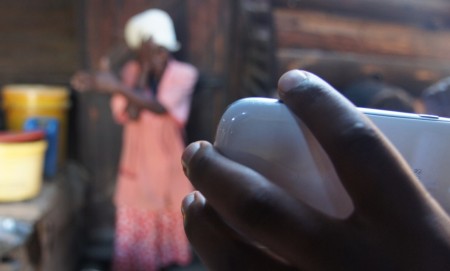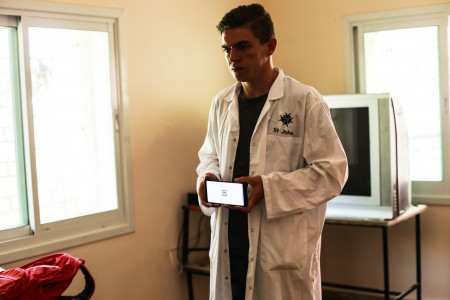
Credit: © Nepal Netra Jyoti Sangh / Peek Vision
Almost a decade ago, Peek Vision developed and validated a smartphone-based distance visual acuity test which has the potential to transform how distance vision is tested across Africa and Asia. However, distance vision makes up only 54% of those who have an untreated visual impairment.
It is estimated that a further 500 million people suffer from untreated near-vision impairments. To identify all of those in need of treatment, it is vital that accurate and accessible tests for near vision are available.
A near vision smartphone-based visual acuity test has been developed by Peek Vision and validated together with research partners at the London School of Hygiene & Tropical Medicine and the largest eye care provider in Nepal – Nepal Netra Jyoti Sangh, to enable the accessibility of near vision testing to all people.
The recently completed study at Sagarmatha Choudhary Eye Hospital in Nepal compared the smartphone-based test against conventional near vision testing and was published in the Translational Vision Science & Technology Journal in December 2022.
The original Peek Acuity app, which tests distance vision only, has been successfully validated and embedded across numerous programmes worldwide. Combining this with digital near vision testing, particularly in populations at risk of presbyopia who can be identified in the same visit, will facilitate the identification and management of both near and distance visual impairments. It may also make vision measurement more appealing to organisers of community health surveys and surveillance who are already using digital devices for data collection. The Peek Near Vision test we have validated in this study could serve this purpose.”
Dr Marzieh Katibeh
Data Insights, Peek Vision
How the Peek near vision test was validated:
In order to collect data, a digital data collection form was used, which randomly selected the sequence of tests and the examiners. Data was uploaded and shared through a secure server hosted by the London School of Hygiene & Tropical Medicine. As part of the study, participants’ demographic information, distance visual acuity, and primary eye condition that led them to attend the clinic were entered into a customised form. Then the result of near vision tests by both the Peek Near Vision test and conventional chart by the two examiners were registered. Each participant had 18 near vision assessments in total.
We conducted two substudies from the outpatient clinic at the Sagarmatha Choudhary Eye Hospital in Lahan, Nepal; in the first one, the screening attributes (fail or pass) options were evaluated and validated. In the second substudy, the quantity of near vision between the Peek Near Vision test and chart were compared, and the differences were plotted against each other and compared.
The research was performed in line with the Declaration of Helsinki.
Results of the validity studies:
The results show the Peek Near Vision Test is valid to be utilised in two formats: (1) a screening tool to identify people with near visual impairment and (2) a quantitative assessment of the score of near visual acuity. Additionally, we found high levels of agreement with a reference near vision test as well as high levels of repeatability among independent examiners. This means that If the same person were to perform the same test twice, you would expect the same result. However, this is not always the case, and it is a measure of how accurate and reliable a test is. There was high repeatability with the Near Vision test showing that the test is reliable and consistent, as the results of multiple independent assessments were in agreement, and results remained consistent when the same examiner tested the same subject multiple times.
This study was conducted in a standardised, controlled setting, which may not always be the case in mass screening programmes where the visual acuity testing is not so rigorously controlled, for instance, testing distance and reading angle. Therefore we will continue testing this product in diverse settings, including a range of age groups, underlying eye disorders, and device models.
This study was funded by Wellcome Trust (207472/Z/17/Z), the National Institute for Health Research and the Department of Health and Social Care and was conducted in partnership with Sagarmatha Choudhary Eye Hospital and the London School of Hygiene & Tropical Medicine. The views expressed are those of the authors and not necessarily those of Wellcome, the NIHR or the Department of Health and Social Care. The funding organisations had no role in the design or conduct of this research.
We thank all of our partners for helping Peek to develop this test and look forward to its future use in research and health programming.
Find the link to the paper here.


